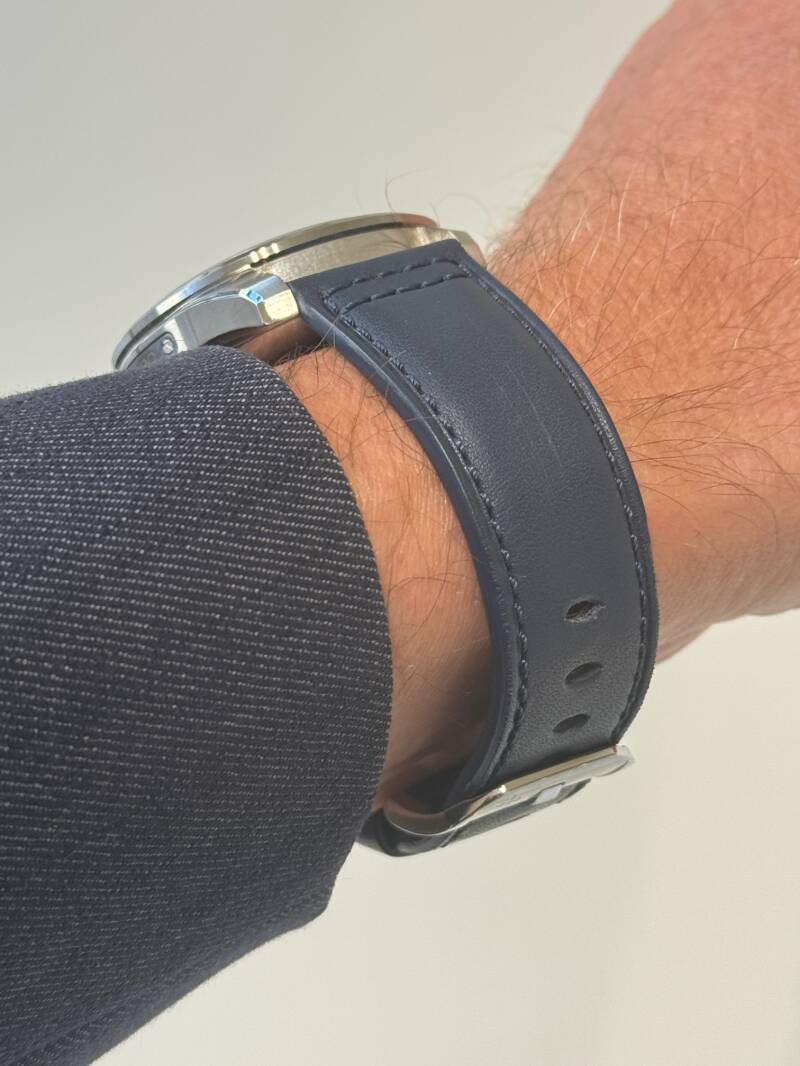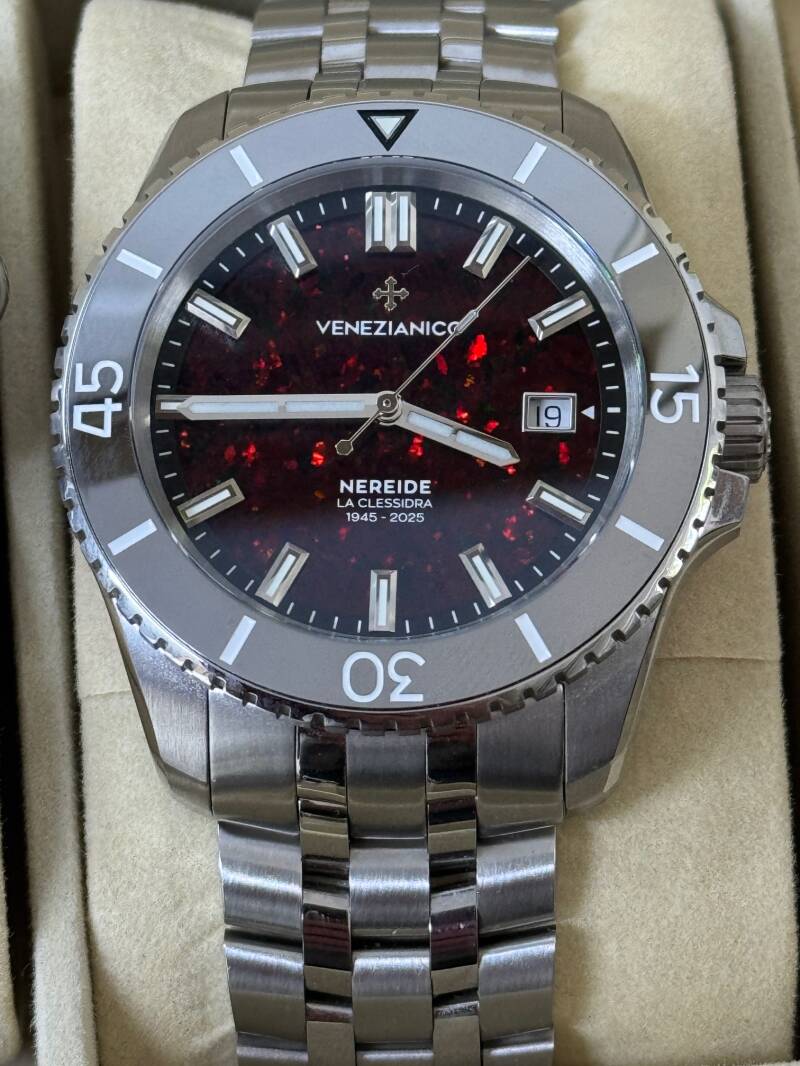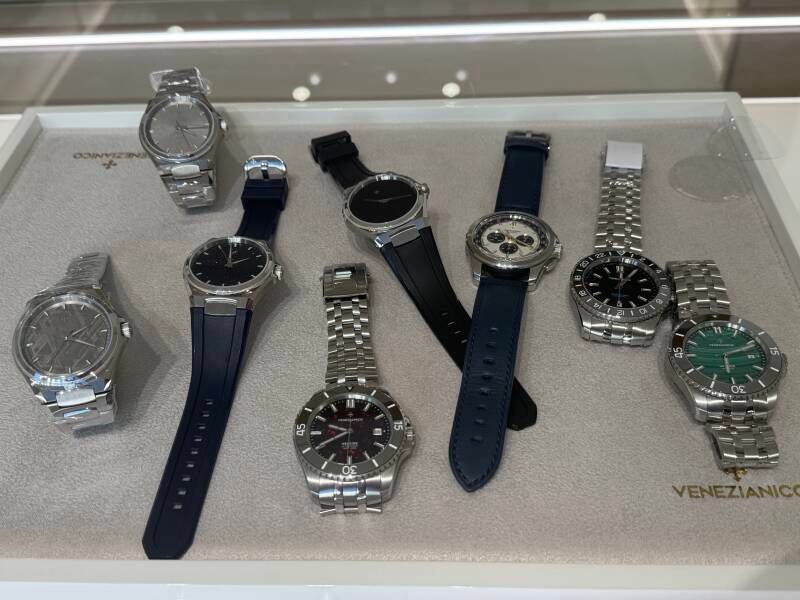
I’ve already written quite a few articles about Venezianico watches, and I own (or have owned) even more of their pieces than I’ve written about, since I haven’t covered all my Venezianico watches. So it’s obvious this (micro)brand has a soft spot in my heart. It’s probably no surprise, then, that last Friday — when I drove my son to Venice airport — I used the return trip as an excuse to visit the Venezianico atelier in person, which is located in the small town of San Donà di Piave. The town is just under 20 km from the airport, very easy to reach by car, and there’s a large free parking lot five minutes walk from the atelier at the town’s entrance. By the way, since I arrived well before their 9:30 opening time, I also personally tested the nearby cafés — and the coffee and croissants are excellent.
I had prepared thoroughly for the visit and had been pestering Alessandro, one of Venezianico’s co-owners, on WhatsApp all week about which watches to have ready for me to see. Unfortunately, Alessandro left for the Toronto watch fair right as I arrived, so he passed all my requests to Mrs. Sylvia, who took care of me instead.
Naturally I wanted to see in person primarily the watches that are relatively new to Venezianico’s lineup. Alessandro confirmed that almost all of them would be available to view during my visit, and most were for sale. The only exceptions, to my regret, were the Arsenale pieces with bronze cases — they look very attractive in the renders. But my disappointment was more than made up for by the information I received a few minutes after I got an email teaser about pre-orders for a new limited Buccintoro model — the 1976. Alessandro promised I’d be able to see that watch at the atelier even though pre-orders don’t open for another week.
So today’s article is a little different. It’s not a review of a single watch; instead I’ll share my first short impressions of the watches I tried on. I’ll start with the brand-new model I already mentioned that isn’t for sale yet.
1. Buccintoro 1976
Almost two years ago Venezianico released (beside a "regular" Buccintoro, which I reviewed here) a limited Buccintoro called the 1969, dedicated to the first Moon landing. For that watch they hunted worldwide for Lemania 1873 movements — the base caliber for the Omega 861 used in the Omega Speedmaster Moonwatch (its successors 1861 and 3861 are still used in Moonwatch models today). Historically speaking, though, the Omega 861 (i.e., Lemania 1873) was never actually on the Moon: the astronauts who walked the lunar surface wore Speedmasters driven by the Omega 321, based on the Lemania 2310.
Back to the Buccintoro 1969: Venezianico collected 100 movements, fully restored them, and even remade parts where needed, building 100 watches that sold out instantly despite the relatively high price of €4,500. I thought about buying one for a while, but by the time I decided they were gone.
Fast forward to now, and Venezianico has managed to source and restore another 100 movements for another new Buccintoro watch. This time the watch is called 1976, inspired by Concorde’s first passenger flight. They even cut a small plate from the original Rolls-Royce Concorde engine blades and engraved the serial number on it, attaching it to each case. Pretty wild. You can read the full backstory here.
Of course I was thrilled to be allowed to examine, photograph, and wear the watch. Since they only published full images on Monday, I promised not to share my pictures before that.







As you can see, I handled serial no. 2/100. Unlike the 1969 — which had dark brown and black tones — the 1976 is lighter with blue accents. The 1969 had subdials evoking the lunar surface; the 1976 seeks a connection to Concorde. The watch is definitely interesting and beautiful. I’m fascinated by the watchmaking passion for hunting down and restoring old calibers (I’ve written about a similar Alexander Shorokhoff project that recreated a Pobeda — see that article). Considering how much work went into this watch and its limited quantity, the price of €4,750 is not unreasonable. But with a watch like this and at that price you don’t just buy a watch — you buy a story. For me personally, the 1969 had a stronger story and a more concrete link between the movement and the watch. The Concorde story is fascinating and deserves its own watch, but I can’t quite find the natural junction between the Lemania 1873 movement and Concorde. Venezianico’s watchmakers’ fascination with that movement alone isn’t enough for me. Personally I'd be far more tempted by another take on the 1969 series (maybe they can’t do that out of respect to the original buyers of the 1969) or even something like a 1974 to celebrate the last successful lunar flight. Or, if they wanted to celebrate Concorde, maybe choose a different movement — by 1976 there were already several automatic chronograph calibers fighting for dominance, and one of those might have been more fitting. Just thinking aloud...
That said, I greatly appreciate and respect the use of restored historic cult movements — and the fact they actually bought and fitted an original piece from a Concorde engine is a real hat tip. Will that be enough for this model to sell out as fast as the 1969? I don’t know — we’ll see when pre-orders open in less than a week.
2. Arsenale
It’s been a while since I last wrote about the Arsenale collection. Most importantly, Venezianico has, alongside new dials, noticeably changed the model itself. Apparently they listened to us online commenters: the new models now have a seconds hand, hour indices, and lume on the indices and hands. All of that added about 1 mm to the Arsenale, so the case thickness is now 9.95 mm.
I was pretty convinced I’d buy one of these new models. As I mentioned in the intro, my first pick would’ve been the bronze version (with a blue dial — I only have a render to show you). I worried the Avventurina might be too similar to my Ultra Black.
In reality, though, I was most tempted by the Platino. For two reasons: first, the dial is made of platinum, which is very unusual; second, it’s the only Arsenale that doesn’t run on a Miyota but on a Soprod V3250 (a Soprod M100 base specially adjusted for Venezianico).



But Platino left me cold. The platinum dial has no “wow” factor — just a boring light gray — and worst of all, the contrast between dial and hands is weak, so legibility is poor for older eyes. Despite the interesting and relatively rare movement, I had to pass.
Then I turned to the other two models. I immediately realized the Avventurina is quite different from the Ultra Black: the blue is truly blue — under certain light and angles it even skews slightly violet rather than black — and there are tiny sparkles in the stone that catch the eye. It’s the complete opposite of the inky Ultra Black. From that point I stopped seriously considering the Meteorite version. The meteorite dial is, as always, interesting and the hands contrast better there than on the Platino, but in the end the Avventurina won — especially once I fitted it to the bracelet.




3. Nereide
I own a fair number of Nereide watches. In fact I realised I’d never properly introduced two of the most interesting ones from my collection, so let me make a short detour.
The first one is the Nereide Aquaforte (using Miyota 9039, price 850 EUR), notable because the case is engraved using the acquaforte technique. Acquaforte is an engraving technique developed during the Renaissance and perfected in Italy by masters like Venetian Giambattista Tiepolo, who used it to craft intricate details and add depth to surfaces. The process starts with applying a protective layer to the metal, where the design is engraved. The plate is then immersed in an acid bath, which etches the exposed areas. Once complete, ink is applied manually to the engraved sections, enhancing contrasts and creating depth and relief in the design.



The second watch is a special edition limited to just 80 pieces — “La Clessidra,” released for the 80th anniversary of Italy’s oldest watch magazine. I don’t have any emotional connection to the magazine; I bought the watch mainly because of the stunning black-and-red opal dial and because it’s the only Nereide with a display caseback (showing Sellita SW200-1 movement). The dial is just insanely good and reflects gorgeous colors in sunlight. I even wore this watch on my visit.




From the Nereide line I primarily wanted to see the newly released Turchese with Sellita SW200-1 (price €1,150 on rubber). Since the dial is natural stone, they prepared ten different pieces for me because each stone is slightly different. I first shortlisted two, and the one I found most interesting ended up on my wrist. Note: the watches are photographed with protective film on the crystal!





Besides that model I also checked out an older piece — the Aureo 42 (€1,295 on the Sansovino bracelet) — and its smaller, younger sibling, the Aureo 39 (€900 on bracelet). Both, of course, have dials treated with 24k gold. In the smaller model, the Miyota 9039 replaced Sellita SW200-1, which is in running in the larger model. Although I generally avoid watches under 40 mm, the Aureo 39 surprised me — it wears very well even on my 19 cm wrist. I like that it doesn’t have a date; the gold dial looks nicer. With a heavy heart I decided not to take any of the Nereide models — the reason being simply that I already have too many. With the number of watches I own, these wouldn’t get enough wrist time.
4. Nereide GMT Ceratung
Even though I own quite a few Nereides, I didn’t have a Nereide GMT. Most of the older Nereide GMTs used the Seiko NH34A GMT, which didn’t particularly excite me given the other options. There is an exception though: the Ceratung GMT, powered by the Soprod V3290 — a movement Soprod developed for Venezianico based on its C125. The bezel is interesting: half of it (the black, night side) is ceramic, and the other half (the light, day side) is tungsten, which is already a hallmark of Venezianico’s Nereide models. The first Ceratung GMT launched in 2023 and is already sold out (ref. 4821501C), and very recently they released an updated version (ref. 4521500S). The new version has a different bracelet (Sansovino instead of Canova), a bi-directional bezel (previously it was unidirectional), and a slightly improved and marginally slimmer case. One Ceratung ended up coming home with me; to liven it up a bit I also grabbed a light blue rubber strap from the Nereide Turchese model that matches the GMT hand and the “Nereide GMT” text perfectly.





5. Redentore
From the Redentore collection I had no particular wants — after all, I recently bought (and reviewed) one from that line. Still, I wanted to see the other colors in the Enigma series, which were released after I purchased the green version. As with my green version, I was impressed by how the dials fade toward black, especially on the leather straps. Definitely some of the nicest straps I’ve seen! Overall, Sylvia and I agreed the red combo is the most beautiful.
While Sylvia was preparing the watches, I wandered around the atelier and looked at the other displayed pieces. I noticed that despite the huge space, there were relatively few watches on display. For a moment I paused at the Redentore 36 pieces that might interest my wife — I only photographed them through the showcase.


As I said, the atelier is very large, spacious, modern, and in a very interesting location. The staff are extremely friendly and professional — another lady joined Sylvia (I didn’t catch her name, but she seemed to be Sylvia’s supervisor). If you have the chance, I warmly recommend a visit!
P.S.: I’ll let you in on one more thing — besides all the watches I mentioned, I was able to admire and wear a finished prototype of a new watch they’re preparing. The dial on the prototype isn’t final yet, though they showed me the final dial version separately (interestingly, I liked the prototype dial better). Even though they allowed me to photograph the watch, I’m not allowed to share those photos yet.
P.P.S.: Apologies for some of the weaker pictures — I shot them on my phone under the atelier’s artificial lighting.




Added on 30.9.2025:
P.S.: My concerns about the new Buccintoro chronograph were clearly unfounded — the watch sold out within an hour!
Add comment
Comments